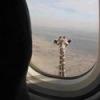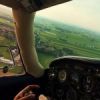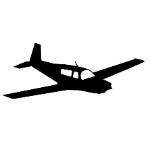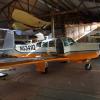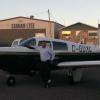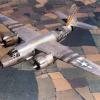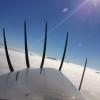Leaderboard
Popular Content
Showing content with the highest reputation on 09/18/2015 in all areas
-
You are partly correct on the physiologic principle and point out a limitation of sat monitors- that with a sudden dramatic decrease in pO2 in the lung alveolus (PAO2), pO2 in cerebral tissues always drops ahead of SaO2 in the capillaries of your finger where it is being measured. However you misuse the alveolar gas equation, which is not a valid estimate of PAO2 at high altitude - a PAO2 < 0 is simply not possible. And a PAO2 of near 0 is not compatible with life - yet a lot of sherpas and climbers manage ok without O2. I'm hardly an expert here, but this seems like a good write-up on limitations of the equation, including what actual empiric PAO2s are at altitude: http://ceaccp.oxfordjournals.org/content/4/1/24.full More importantly, I disagree with the conclusion that sat monitors are dangerous and have no place in an aircraft. I do suspect they will be pretty useless in a sudden decompression at FL430. But if your O2 flow stops working at 17,000, no healthy person is going to pass out quickly. Yet one might feel sick or do something stupid. If you feel funny, you can get accurate SaO2 feedback within a minute or two that tells you that you should come down immediately. At FL250, useful consciousness without prior acclimation is much shorter, but there is quite a bit of variability from person to person, and a guy who lives in Breckenridge will do much better than me. If your O2 is not working during your climb to this altitude or forgot to turn it on, you can certainly get some warning from a sat monitor. If you are using an inadequate O2 flow or the flow gradually drops unnoticed at FL250, the SaO2 monitor can also warn you. At relatively low altitudes (5,000-12,500), there is also tremendous variability in the amount SaO2 drops from person to person, and a monitor can help guide O2 use in this lower risk setting, particularly at night. I also wouldn't hesitate to use a monitor to tune my O2 flow rate at 12,500-17,000. I say use a monitor early and often in these settings. I think they are much more likely to cause anxiety and confusion from false low readings or not picking up a reading than give false assurance from normal readings. Lastly, in a hospital environment the monitors are certainly not merely useful for general trend monitoring. They are useful for moment to moment life saving decision making on patients because changes in systemic O2 delivery are reflected in a very short time. Yes they lag behind cerebral pO2, but that knowledge is built into our interpretation. There is no reason I see they can't be used on one's self for the same purpose in an aircraft, albeit without complacency- it won't save you every time at higher altitudes if you are already too impaired to act on the low number.7 points
-
I would like to clarify a couple of things about the post above questioning the utility of a pulse oximiter at altitude. 1. There is no lag between central oxygenation and cerebral oxygenation except for the cardiac output that is diverted to the brain, heart and other high-oxygen consuming organs in states of cardiovascular stress. In a person with a normal heart (i.e. you have a third class medical and were not a blue baby as an infant) there is perfect mixing of oxygenated blood as it leaves the heart. The body doesn't get to decide that it is sending more oxygenated blood to the brain, but it does have a mechanism to preserve cardiac output to the brain (see #2, below). 2. If you are peripherally vasoconstricted for reason number (1), above, or another reason, like your cabin heat is off and you're going all Memphis Bell in the flight levels with Piloto's bomber jacket and no gloves, you will either get intermittent readings or will be unable to get a reading on your pulse oximeter. They may be unreliable, but they will mostly be unreliable by showing a low value or no value. For this reason I recommend one with a pulse waveform (what we call a pleth waveform) - it will give you an idea of the quality of the measurement at any given time. Carl is correct that muscle movement can affect a pulse ox reading negatively. 3. The time it takes for a red blood cell to get from the venous circulation to the arterial circulation is pretty low - and importantly less than the time of useful consciousness in the flight levels. 4. The brain cares about oxygen delivery to tissues. For the math/medicine nerds in the group, Delivery of O2 to the tissues (DO2) is: DO2 = cardiac output * oxygen content per mL of blood DO2 = cardiac ouput * [((SaO2%/100)*1.34*Hemoglobin concentration) + 0.003*PaO2)] As you can see the real driver for oxygen content is how much hemoglobin is bound to oxygen. The pressure of oxygen in the gas exchange parts of the lung drives how much oxygen is bound to hemoglobin. Lance Armstrong might do 30 sec better in the flight levels because he drove up his hemoglobin levels (cheating bastard). 5. As alluded to previously, the reason you feel air hungry when you hold your breath is mostly due to the buildup of carbon dioxide in your blood. People don't become nearly as air hungry with hypoxia - in fact with a normal carbon dioxide level (which will not be impaired in the flight levels) and a normal blood pH you can go on happy as a clam without feeling any need to breathe - ask the folks who have been to the altitude chamber. 6. The reason your oxygen saturations can last longer at seal level with holding your breath is as follows: When I want to keep someone's oxygen saturations up for as long as I can when I am going to make them apneic on purpose is doing something called pre-oxygenation. I do this when I place a breathing tube in someone. Pretty much I try to let them breathe 100% oxygen at Sea Level for a period of time. The purpose of this is to essentially wash out the 70 odd percent atmospheric nitrogen that out lungs are filled with with 100% oxygen. An adult with normal lungs can last with a normal oxygen saturation for between 3 and 10 minutes completely apneic with this method. That's a really long time in my book. The reason is that you create a reserve by which oxygen delivery across the lung can occur. You still build up CO2 over time, but this is a remarkably useful procedure. I take care of infants and children, which have much less of a lung functional volume, a higher heart rate and higher tissue oxygen consumption, so instead of getting 3 minutes, I get 30 seconds-1 min of time to do what I need to do before they start dropping oxygen saturation levels. When you take a deep breath in and hold your breath, you are doing something similar but instead of filling the lungs with 100% oxygen you're starting out with 21%. It's somewhat but not very useful to try to hyperventilate to wash out carbon dioxide from the lung prior to holding your breath - this is what those deep sea free divers do. Your ability to hold your breath and maintain normal saturations will necessarily be less than if you pre-oxygenated with 100% oxygen. Now lets do the same thing in the flight levels. You are entraining your lung with a lower total pressure of gas even if it's 100% (via a perfectly working non-rebreathing mask). Cool. Can you hold your breath for a time longer than at sea level with 21% oxygen? Nope. Why? Because the partial pressure of the 100% oxygen is still low because the atmospheric pressure is 400 mmHg instead of 760 mmHg. You fill the alveoli with less pressure of oxygen (even though it's 100%) and you have fewer oxygen molecules per volume unit of alveoli. Less driving pressure to get oxygen across the lung and bound to hemoglobin in the blood. This also shows why it's really dangerous to use a nasal cannula in the flight levels - with that you are replacing 21% oxygen with 35% oxygen and a coordinate decrease in the percentage of nitrogen. The atmospheric pressure is still what it is (Mt. Everest). However, you just took what little ability to sustain a pre-oxygenation reserve and cut it significantly. Having a small reserve may not mean much in terms of time (20-30 sec? Maybe...), but that 30 seconds of useful consciousness may be the difference between reaching for the backup oxygen bottle and not making it. So please use a mask setup as per the regs if traveling in the FLs. What does the body do when oxygen sats are lower? What it can... namely your heart rate will increase to increase cardiac output and via that oxygen delivery equation get more ml/min of oxygenated blood to the brain and the heart. You'll also breathe faster (you have both carbon dioxide measuring apparatus in your brain and you can sense hypoxia even though you don't feel as "air hungry" when hypoxic), and you'll divert blood from muscles and gut to brain and heart. The brain is good at extracting every bit of oxygen it can your the saturation of blood that returns to your heart (the mixed venous oxygen saturation) will be lower. I think Carl was describing this phenomenon of diverting useful cardiac output and increasing oxygen extraction in his post, above, but it should be recognized that a mechanism to achieve this is peripheral vasoconstriction and that should be reflected in the quality of the pulse-saturation waveform. Long winded, but in summary a pulse-oximeter should be used on flights above (pick your altitude - depending on your lung health, age, personal reaction to altitude) 8,000 ft, 10,000 ft 12,500 ft.... I don't know the answer but that's for each of us to determine for ourselves. Please use a pulse ox with the caveat that they are incredibly useful but not perfect almost real time measurements of what your oxygenation level is. If you are feeling symptomatic and the pulse ox is saying 100% something may be wrong... use your backup oxygen and consider the possibility of carbon monoxide poisoning. If you feel symptomatic and you're not sure if something is or what's wrong quickly get to a lower altitude now and then figure out your situation once your time of useful consciousness has been addressed. Stay safe up there... - Brad (my IRL credentials are Pediatric Critical Care Medicine Doc, Aeromedical Transport Doc, PhD in Molecular Physiology) (@ Carl on the side - check your averaging for your pulse ox - in peds we keep the averaging super short, the delay you see may be a reflection of the averaging).4 points
-
Just a personal observation from over 35 years as a CFI, 40 years flying for a living and 49 years as a licensed pilot. I realize that I am most likely preaching to the choir here, but there are more than a few out there who aren't "proactive" when it comes to training and proficiency. I'm sure we all know plenty of guys (and probably a few here) whose only recurrent training events consists of a BFR. The guys I hang around with get sim training every 6 to 12 months in addition to other periodic training events such as aerobatic training, high altitude physiology training (altitude chamber) and attend frequent safety meetings, seminars, and other training courses. The guys you read about in the accident reports usually aren't the ones that you see attending the meetings, seminars, training courses, etc. The guys you see participating in those are a fraction of the total pilot population. Just saying.4 points
-
Most of us we're told something along the lines of "It's a license to learn" when we got our license. Many of us don't appreciate just how literal and serious that statement needs to be taken. The problems begin when we stop being "student" pilots. One of the reasons why I enjoy participating in this and other aviation forums is that there is so many experienced guys here who are so willing to share their knowledge. There's much for all of us to learn.4 points
-
Carl, help me understand something, if you would... i have a fancy pulse-ox. I kind of know that it is working because it is graphing the pulsation that it sees. Then it gives my heart rate and it's best estimate of oxygen concentration in my blood. if I have an oxygen problem, it displays a low number with an elevated heart rate. it confirms what I am seeing, blurred vision, and what I'm feeling, elevated HR. It explains the additional deep breaths I'm taking. it works as a digital reminder to increase or check my O2 system. isn't the 'no place in an aircraft' a bit strong? What else do I have to rely on that is better? two minute old data is pretty good at 12k', unless we are at 25k' where two minutes just isn't... back to the re-design of O2 systems and their operations for that harsh of an environment. best regards, -a-3 points
-
Without trying to be disrespectful I have to wonder what group of pilots you're hanging out with. Your statements above seem to ignore the MANY pilots I encounter regularly attending safety meetings, seminars, training courses, etc. There's been a tremendous effort by local and distant participants to develop and train Formation Flying groups across the country with one of the BEST right here in Texas. If I'm not mistaken the Mooney Summit sold out again this year. And don't forget that the very subject of this thread was enroute to attend a Mooney PPP. I for one am always seeking more knowledge and experience, and I suspect that there are many many more like me. There are certainly pilots who are slackers, but hopefully not in the numbers you imply. Keep training for sure, after all it's only a license to learn. Cnoe Sent from my iPad using Tapatalk3 points
-
This "test" is not valid. The problem with holding your breath is that CO2 levels increase the bloodstream, which causes its own problems, this is why you can't just put a bag over your mouth and become hypoxic. I have tested one of those small O2 canisters that give you 30 breaths, my O2 levels go from 90 to 97 with 2 breaths, that's only 20-30 seconds between readings. For a person at rest, it's takes about 1 minute for blood to make the round trip through the body, so the blood at the finger is half way on its trip, 30 seconds, as you become hypoxic your heart rate increases, so drop that some more. Of course these are averages, and depends on you fitness level, age, weight, etc. Obviously if you lose O2 at 25000' or higher, waiting that long it too much. This is why you should have an airflow indicator on each persons air hose and a air pressure gauge as well, which should be checked as part of your preflight. The airflow indicator should be part of your scan, it will give you an instantaneous indication if airflow has stopped. Having a couple of the small O2 cans in your flight bag could provide O2 long enough to get to lower altitude, they are cheap insurance, just make sure they aren't made in China.2 points
-
I do appreciate your observations. As a late bloomer I'll never reach the level of experience attained by many on this forum but I'm doing my best to learn all I can along the way. I'm just glad to be hanging around many active pilots and perpetual students of flight. I am encouraged by what appears to be a trend of significant decline in serious/fatal GA accidents. "Something" is apparently improving flight safety, but alas the world still remains an imperfect place. Sent from my iPad using Tapatalk2 points
-
Three photos from today... This is from my first flight where I was able to take the plane out of the hangar, do all the preflight tasks, fly it and put it back without any help. simple pleasure to accomplish all those tasks. thanks to all the MS people that have helped me get this far. about the photos... 1) these are the repurposed tug and tow bars I used. Making a tow bar sounds a lot more simple than it is. Just a bit of loose fitting or flexible rod keeps the tow bar from working. 2) the red one is from Redline aviation. It just works as expected. Linn Kastan, the owner, is a pleasure to work with. I had difficulty purchasing something that was specific for brand B. How hard would it be to update the website to say Brand B and Mooneys.... 3) the block of dirt was installed above my front wheel by some ingenious dirt daubers. My plane has been in a hangar for all but 24 hrs of the last 3.5 years. 4) the block of dirt...again editing is not going to be my future... thank you people. best regards, -a-2 points
-
Pulse oximeters are dangerous. They are great for showing trends in a hospital environment, but have no place in an aircraft. Pulse oximeters are worn on the extremities; because of this location they present a lag between central oxygenation, cerebral oxygenation and peripheral oxygenation. This lag may be upwards of 2 minutes. This depends on several factors such as cardiac output, muscle movement and ambient temperature. So, what you are seeing has already happened, it is in the past. Go on, you are in your kitchen; put your pulse-ox on. Walk around and breathe, look at your reading, 98%. Now hold your breath. Time how long it takes to get to 90% (a moderate level of hypoxia approximating an oxygen pressure in the blood of 60 torr). I bet you can’t hold your breath that long. Why? Because as you are holding your breath the oxygen level in the blood drops fast. It is felt first in the brain. But because you are checking it at the periphery, deoxygenated blood will get to that location in the longest amount of time. Oh yes and you were walking around right. Try it again after sitting for a while in one spot, sit on a couch for thirty minutes and repeat the test. Hold your breath until you reach a sat of 90%. It will take longer for the extremities to be perfused. Your brain will be hypoxic much sooner. Now don’t try this again at the flight levels, where it might be a bit cooler, blood has pooled in the extremities. Remember get your sat monitor up to 98% to start. Remove your oxygen; your cerebral oxygenation will tend toward zero within one minute, one cardiac volume cycle. The only reason it doesn’t go there immediately is due to stagnant oxygenated blood being circulated, your oxygen to your brain is coming from your fingers, not from your lungs. Now glance at you pulse-ox as you start to black out. What does it read? 98% give it a couple of minutes to adjust. Out of time. Pressurized cabins have a cushion, even when they fail, they leak and the pressure does not go immediately to outside pressure, giving the crew (two pilots) time to put on their masks. With unpressurized cabins you are already breathing outside the plane. And there is really nothing outside to breath. 25,000 feet pB =282.4 mmHg PAO2 = 21%(282.4-47 ) – (40)(1.25) PAO@ = -0.5662 points
-
Mooney emailed me the Service Bulletin, which doesn't call out a ending caster angle, just a beginning measurement and a shim if you are outside that. We manufactured a shim, 0.120" 1.25 dia 4130 cond. N. tubing, and I finally got to test fly it today. PERFECTION... No darting to the left. Can keep my heels on the floor to work the rudder and not feel as though I have to cover the brakes to keep her on the runway. Thanks to all, especially M20Doc. PS - the shim moved the center of the axle 1.15" behind the centerline, it had been 0.375 in front of the centerline. sbm20-202.pdf2 points
-
2 points
-
I just completed my annual. 100 hours worth of flying, but it only took 63.7 hours because of the exceptional speed and economy of my Mooney.2 points
-
It is now $100 for the four pedal boots and $60 for the Johnson bar boot, both black leather from Aero Comfort. $12 shipping. Ordered. Airtex carpet came in today. Its perfect!2 points
-
Well, Mooney 7741M is in for annual. Looking at the books I ended up with a few more hours this year over last year at annual time. Looks like I had 76 hrs for this year (annual to annual). Not as many hours as some, but more than others. I think the year before I was at about 50 hrs. My two trips to New England accounted for about 20 hrs. It felt good this year really stretching the legs of the Mooney and getting the longer trips in. Flying it the way it was meant to be flown. Only bad thing about it is all your relatives now think you can fly them anywhere anytime now..lol. My dad has told me the only states that his military career did not take him was North Dakota, Oregon and Idaho. He has marked these on his bucket list with hopes that we can do them in the Mooney. I told him these states might take more flight planning than my New England trips , He is only 83 yrs young, so I've got some time to plan. 76 hrs annual to annual, no bad IMHO. -Tom1 point
-
Reading through all this commentary (which I find truly informative) I now realize the sort of Russian Roulette I was inadvertently playing in my many FL 250 to F 270 flights across the country. Sure I always kept a back up (to the built in bottle), portable O2 bottle hooked up with its own regulator and masks, and a pulse oximeter that I looked at occasionally, but I see that I was truly lucky. As I mentioned earlier in this thread I now fly a J, and I won't be up to those flight levels in my current airplane. As to the long winded IFR clearances, we have been trying for years to just say: Clearance Alfa for 30 and Clearance Bravo for 12. The wording never seems to change: For runway 30 departures: "After take off, maintain runway heading, climb to 2000', within 2 miles of the airport turn right to a heading of 120, maintain 2000" until crossing the Oakland 165 radial (see, we still have use for the VORs), climb to 4000', expect 9000' five minutes after departure, squawk xxxx, contact Nor Cal at 135.65"1 point
-
Couldn't agree more. Same configuration here, minus the cowl cover (she's always hangared). Factory is putting these on as options for new aircraft and retrofits for existing...I've used both "major" brands of heaters between several aircraft, and found the Reiff to be far superior.1 point
-
The FAAsteam has some data on those that actively participate in wings seminars , activities and those that don't with respect to incidents and accidents and violations. The data heavily favors active participation in safety events1 point
-
I'm with Ward's sentiments. What you see on a web board is often a much nicer picture than the guys that don't participate in online safety discussion.1 point
-
I hear millennial Mooneys with their magenta lines can't be trusted... GenX Mooneys are all manual and analog... GenY Mooneys have digital ADFs... Boomer Mooneys have wooden tails... Go GenX, -a-1 point
-
The most important component in a survival kit is knowing how to survive. First, is the will to survive. There are several excellent video productions on survival in the tropics, winter, and in general. They are "buried" in the FAA website and you can get the DVD's by just asking. I became aware of these during my AME training. Having a survival kit without knowing the fundamentals of survival is like having a set of engine tools but never learning how to use them. I made up a light weight kit I have on the hat shelf, weighing slightly less than 10 lbs. Without going into details, the first thing on top is a 406 ELT-in case the aircraft is a crispy critter and it's 406 is fried. Next layer is first aid materials. After any medical issues are address, next layer is signalling materials. Next is shelter. Finally, food, water purification, and "tools". If anyone is interested, can attach my article on survival and the kit that was published in our local pilots magazine a few years ago. Aviation Survival Kit PDF.pdf Aviation Survival Kit PDF.pdf1 point
-
1 point
-
The value of the ADF here in the states I am sure will diminish even further when Rush is no longer aired.1 point
-
Gee Ned, we pull up that same approach on our trusty non-WAAS G1000, and "follow a magenta line." If we want to truly task saturate ourselves, we could tune in the Center Point VOR and look to see that the little blue arrow is pointed at 084 degrees at 10.7 NM. But then again, our little Mooney was born in 2006, and was not privileged to merit a true ADF. Alas...1 point
-
Woo-hooo! Anthony is back! Just took a little extra skull sweat and some of what we call "fixin" down here. Bet that makes your New Jersey breakfast taste better, too. Got a little mower, some bar stock, a few doodads and screws . . . Now a plane that you can move by yourself. It's a whole different job than pushing around my little C.1 point
-
Data point... 65C had the roll trim on the yoke as well. best regards, -a-1 point
-
Yeah, I think I can hear what Ward's trying to say, but I gotta agree with Chuck. Most all the pilots I've ever met LOVE to learn. In fact, I would make the gross generalization the OTHER way. People who don't like to learn, who can't "stick with it" and learn the hard things... never become pilots. None of us had to become pilots to fly. I sit next to people several times a week on Southwest or United who are very happy to let someone else figure out the flying stuff and let them just sit there and have another drink. But we all took a flight and said to ourselves, I gotta LEARN how to do that! This is obviously a very unfortunate accident. And I sincerely hope we learn exactly what happened and what caused it. Obviously the pilot was comfortable flying in the flight levels and had done it many times as evidenced on FlightAware. It's dangerous, but he was comfortable with the risk. It's dangerous to fly single engine IFR, it's dangerous to fly single engine at night. Hell, it's dangerous to get in our little Mooney's and go fly period. But we all accept the risk. This has been a great discussion of what needs to be done and considered when flying at altitude. And I appreciate it even though I fly a C and I'm pretty sure my best defense against hypoxia is the 180hp fan up front. But I'm not going to even consider that the pilot was being reckless, foolish, or complacent. If I go down that path, it's time for me to sell the plane.1 point
-
Virginia is a Southern state, away from DC. Culturally and geographically, to say nothing of weather-wise, West Virginia is completely different. Nice people, though. Where I'm from, a rare snowfall means that everyone stays home until the roads melt clear. It was quite a shock to me, having been in WV and OH for almost 15 years, coming back South again, everyone was startlingly polite. All the tea is sweet, and barbecue is pork. To Yankees, barbecue means to cook (anything) on a grill; to us, it is smoked pork, served with sauce and usually Cole slaw and baked beans, although other sides are often available. (Don't tell this to anyone in Texas . . . They think barbecue is BEEF! ) besides, WV broke away from VA in 1863, specifically to exchange their gray uniforms for blue, because they had more in common with those people than the Confederacy. of course, if you're in Canada, most of the country is "the South."1 point
-
1 point
-
Ward well said and thought out, just add when you think you've learned it all or enough it's time to throw the keys in the trash....before you injure or worse to an innocent person..or people.1 point
-
1 point
-
1 point
-
I'm really glad we're having this discussion. We're assuming that he was hypoxic and that's probably a pretty safe bet, but we'll probably never know what really happened until the autopsy report comes back - it could also have been a medical issue (stroke/heart attack), CO poisoning or (Dare I even say it?) suicide - but, it doesn't really matter. It's a discussion well worth having. Bottom line is that this all underscores the need for ongoing training and I'm not talking about a simple flight review every couple of years.The problem lies in the approach many of us take to training. The FAA gives us the Practical Test Standards which, by definition, define the minimum acceptable standards. These minimum standards then become the training goals of 98% of the students out there. Think about it, their personal goal is to achieve the minimum required standards. It seems pretty foolish when you think about it doesn't it? Then, just as soon as those minimum standards are met, most pilots stop their training, take their checkride and hope to live happily ever after. From then on out, it seems the question most pilots ask themselves is what's the minimum I have to do to keep current? How many of us equate currency with proficiency? And we wonder why we have so many accidents?We all have our personal flying styles and missions, so when it comes to what would be adequate ongoing training, one size certainly doesn't fit all. But lets face it, a few things would benefit practically everyone of us - extreme maneuver/unusual attitude recovery, taildragger and glider training. Add to that list mountain flying for those of us who are new to flying in the tall rocks and high altitude physiology/altitude chamber course when/if you plan on spending any time in any airplane above 10,000' msl - pressurized or not. Is training like this legally necessary? No, of course not. Do you need it? If you're like me, you probably would benefit from it. One thing for certain, this type of training would save many lives every year.1 point
-
And you guys thought I was nuts for posting pictures of those women. In addition to survivability in cold water, they offer a solid flotation device.1 point
-
if Mike is all proxied out, I'll be there Friday morning. PM your wish list(s) to me, as long as I don't want the same thing, you'll be good.1 point
-
I have a MP/FP gauge from my 77 J for sale in case that is a better solution. Sent from my iPad using Tapatalk1 point
-
An auto parts store that sells a lot of paint will have a "profit" machine. It's essentially a camera like device that will give them the exact mix ratio to match your current paint color (fade and all), taking that snap shot off the panel you bring in for matching. We use this method all the time at my truck dealership to match paint for touch-up. Our local NAPA store will even put the paint in a spray can, or in a small 1/2 pint can and then we spray with a portable glass device (about $15) that uses a small compressed cartridge to spray it, much like a professional spray gun. On non-spray touch up, we use small artists brushes that we buy from a department, art supply, or box store. I did that exact procedure this year during my annual on my Rocket and it was amazing how those little touch ups cleaned up the look of the plane.1 point
-
I'd drive there...got a 4x4 Jeep so no problem. Wouldn't take any model Mooney in there...1 point
-
There is of course no difference at all. There are a lot of fans who are obviously jealous of New England. Go Pats.1 point
-
1 point
-
I got a set of the Halo's a year ago at OSH. That meant the wife got the Zulu2's. This spring she asked to try my Halo's. So of course she never gave them back and I was stuck with the Zulu2's until OSH this year where I got another set of my own. I'm not sure our Dog in the back seat really appreciates the quality of the headset she's wearing now.1 point
-
I just hope Garmin doesn't buy out ForeFlight and reset market to Garmin is only option. I love the innovation and customer service of the ForeFlight guys.1 point

